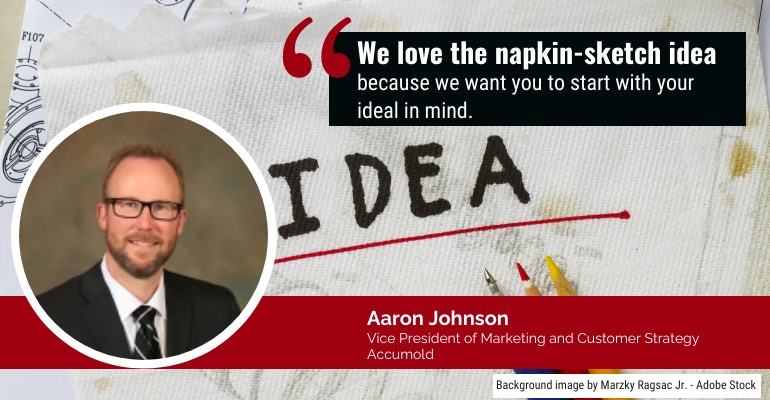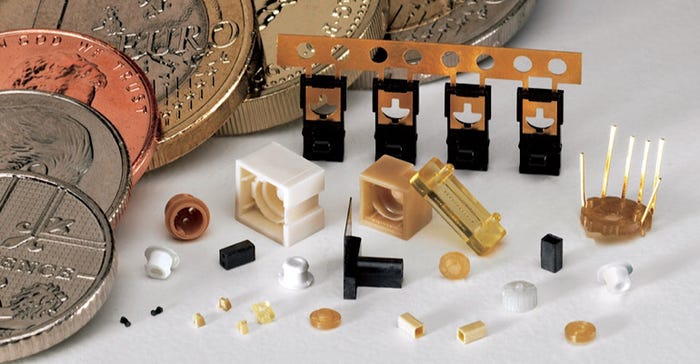Micro-molding expert Aaron Johnson tackles some of the most frequently asked questions he hears about miniaturization today.
November 30, 2020

At Virtual Engineering Week, Accumold's Aaron Johnson tackled several key questions about miniaturization and micro injection molding, from the most basic to the more complex. Johnson, vice president of marketing and customer strategy at Accumold, is recognized as a leader on the subject of micro injection molding and has worked for Ankeny, IA-based Accumold since 2005.
What is micro molding?

"What is micro molding? In one sense it is still injection molding," Johnson said. "It's the process of melting plastic into a form and letting it harden, and you have a variety of different constraints around that."
So in the most basic sense, micro molding is injection molding. Beyond that, however, Johnson defines micro molding in one of three ways.
Certainly the size of the molded part is a big factor in defining micro molding, Johnson said, noting that the smallest commercial part Accumold manufactures today is only about 800 microns long.
Micro molding can also be defined in terms of tolerances, Johnson said.
"It's not uncommon for us to have positional or some kind of geometry tolerances in plus or minus just a few microns in some cases," he said.
The third way that Johnson defines micro molding is in terms of micro features.
"It can be larger parts, something that has micro features to it, maybe it's a housing but it has a little micro-fluidic section to it that requires very high precision, high quality components," Johnson said. "So it's micro in size, micro in tolerance, micro in features, and in a lot of cases it can be all three of those. But usually there's some compelling nature to the component to make it true micro molding."
Another good indicator that your project requires micro molding, he said, is if you've taken a part to a traditional injection molder and they tell you it's too small or the tolerances are too tight for them.
Where do you start when embarking on a miniaturization project?
Johnson recommends that engineers start with their ideal in mind. He said he's often been at a trade show where someone will tell him they're not quite ready to talk about micro-molding needs yet because they're still designing their part. But that's actually the best place to start talking to a micro-molding partner, he said.
"We want you to be able to maximize your creativity, maximize what you're after through your design, and perhaps there are things you can do that you might not know you can do," Johnson said. "We love the napkin-sketch idea because we want you to start with your ideal in mind."
He says he once had a mechanical engineer customer tell him that everything he designs is the size of his monitor.
"It sounds funny, but we've seen some incredible designs come across the way, but just because you can draw it in CAD doesn't mean you can mold it, or just because you can 3D-print it doesn't mean you can mold it," Johnson said. "So looking at, what are you after? What is the ideal state that you're looking for? Then we start looking from there to see how close we can get to your ideal, and in some cases, you might be pleasantly surprised."
The moral of the story is it's never too early to start talking with your micro molder about your design.
How do you do more in the same amount of space or less?
"When we think about today's smartphone technology, there was a race not that long ago to see how small they can get. Then they got big again, and now they seem to have stabilized," Johnson said. "But if you take the form factor of the smartphone you have in your pocket today and you just go back five years and you think about storage space, the speed, the camera quality, the functionality ... it's just so much faster and better today, and a lot of that is enabled by micro technology. By making things smaller you can have more functionality."
Miniaturization is especially important in medical device development. From drug-delivery devices to implantables and surgical tools, smaller tends to equate to less invasive procedures, faster recovery times, and better patient outcomes.
What role does miniaturization and micro molding play in imaging, sensing, and medical applications?
Johnson shared some examples with Virtual Engineering Week attendees of some cool technologies enabled by miniaturization and micro molding, such as micro-optics (micro lenses and mirrors used for imaging, sensing, and medical applications).
"Micro optics take on a very special injection molding process because not only are we talking about small parts, fine details, and certainly small tolerances, micro-optics takes that to an even higher level," he said.
There are a number of considerations and challenges involved with micro-optics projects, such as optical-grade surface finishes and material clarity, but Johnson said micro-optics is one of the fastest-growing sectors of the sensor market and miniaturization.
"When you think about the types of imaging or the sensing of the diagnostics that you can do in the med device space is just phenomenal today, in large part due to a lot of micro technologies like micro molding," Johnson said.
What if I have miniaturization or micro-molding questions that are not answered here?
It's not too late to register for Virtual Engineering Week to listen to Johnson's presentation on demand. Another good source of information about micro molding, and Accumold in particular, is the company's Qmed directory listing, which includes contact information along with other useful content.
Finally, you can read more of Johnson's miniaturization and micro-molding tips here, based on a similar presentation at BIOMEDigital in early November.
About the Author(s)
You May Also Like




